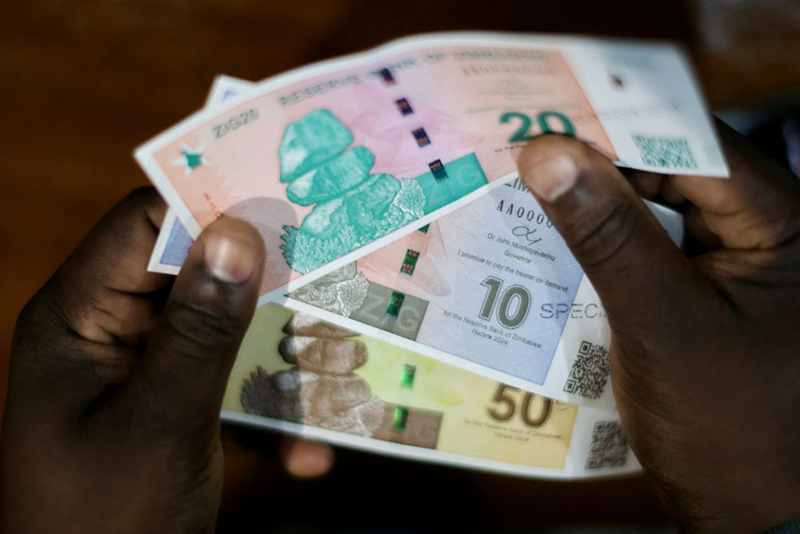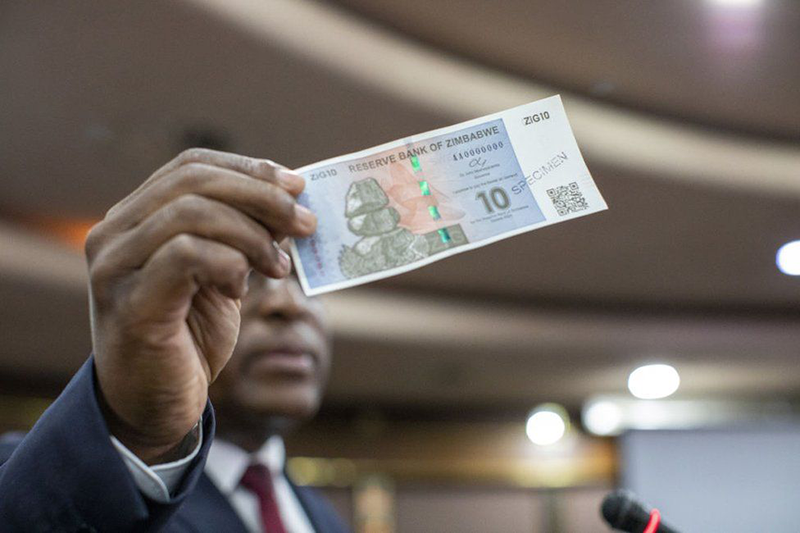- Featured
- No Comment
ZiG currency surges in first week of trading amid market skepticism

By Xinhua
HARARE: Zimbabwe’s newly launched gold-backed currency, known as the Zimbabwe Gold (ZiG), has hit the ground running, gaining 1.1 percent against the U.S. dollar in its first week of trading.
The surge aligns with the robust rise in gold prices, driven by investor demand for safe-haven assets amidst escalating tensions in the Middle East.
The ZiG replaced the inflation-battered old Zimbabwean dollar and started trading on Monday, following its launch by Reserve Bank of Zimbabwe Governor John Mushayavanhu on April 5.
Zimbabwe’s sixth currency solution, ZiG, debuted at 13.56 per U.S. dollar on Monday and sustained its upward trend, closing at 13.41 per U.S. dollar by the end of Friday’s trading.
Despite initial market confusion surrounding the new currency, most banks, traders, and businesses successfully converted their old Zimbabwe dollar balances to ZiG. This sets the stage for ZiG to circulate alongside other foreign currencies under Zimbabwe’s multi-currency regime, which will remain in place until 2030.
Electronic ZiG has commenced circulation, with ZiG notes and coins slated to enter circulation on April 30, according to Mushayavanhu. Notes will be available in denominations of 1, 2, 5, 10, 50, 100, and 200, alongside half and quarter ZiG coins.
Mushayavanhu has said that the ZiG will be backed by a basket of foreign exchange reserves and precious minerals, mainly gold.
At launch, he stated the central bank had 285 million U.S. dollars in reserves: 100 million U.S. dollars cash and 185 million U.S. dollars gold. This backs the local currency, valued at 2.6 trillion Zimbabwean dollars, needing 90 million U.S. dollars in cover from gold and cash.

“The total 285 million U.S. dollars represents more than three times cover for the ZiG currency being issued,” Mushayavanhu said, adding that the central bank commits to maintaining a steady buffer of foreign reserves to ensure full coverage for the currency at all times.
The introductory rate of 13.56 per U.S. dollar caused a notable depreciation of the old Zimbabwean currency, the bond notes, which the central bank permits to circulate until April 26.
However, informal traders reject devalued bond notes, impacting change availability. Commuters now pay one U.S. dollar instead of 50 U.S. cents due to the shortage. Commuter operators demand one U.S. dollar for two passengers, as they refuse bond notes.
“It’s not always the case that I find someone to pair with. In most instances, I am paying one U.S. dollar per trip and this means that I am going to fork out much more on transport this month than I had previously budgeted prior to the introduction of the ZiG,” said Takemore Tera, a Harare commuter.
Around 80 percent of business transactions in the country are already in U.S. dollars. Mushayavanhu aims for ZiG to bring stability and address the currency crisis.
He pledges to adhere to the central bank’s constitutional mandate, avoiding quasi-fiscal activities to prevent inflation and exchange rate instability. He expressed concerns that the ZiG’s appreciation against the U.S. dollar might lead to deflation, as strengthening currency may deter price hikes.
Since abandoning its local dollar in 2009 for a multi-currency system, Zimbabwe has faced persistent high inflation and currency woes. Many Zimbabweans are indifferent about the ZiG and question its potential success compared to the failed bond notes.
Investment banker Nigel Chanakira, speaking on state radio, believes the new central bank governor deserves a chance to revive the local currency. Success will be measured by whether Mushayavanhu can restore public preference and confidence in ZiG over the U.S. dollar.

“Change is here with the new currency. We must give the new governor a fighting chance,” Chanakira stated, addressing public doubts about the governor’s ability to handle the currency crisis. He emphasized the need for measures to gradually promote ZiG’s use, aiming for a return to a single currency by 2030.
Mushayavanhu plans to boost demand for ZiG by mandating companies to settle half of their taxes on Quarterly Payment Dates in ZiG. He anticipates increased ZiG demand in the second half of the year as companies pay half of their quarterly taxes in ZiG. This move aims to reduce U.S. dollar usage in the economy from 80 to 70 percent by year-end.
Mushayavanhu expects a U.S. dollar to ZiG ratio of 60:40 next year, and 50:50 the following year, indicating growing acceptance.
Finance Minister Mthuli Ncube plans targeted policy interventions to bolster ZiG usage, including specifying fees and taxes payable in ZiG. He also aims to designate certain services purchasable in ZiG to boost local currency demand.
He said the new currency and the cut in interest rates from 130 percent to 20 percent were part of the broader measures towards the country’s long-term de-dollarization agenda.
Economist Brains Muchemwa is optimistic about the new currency.
“With the right safeguards, curtailing unproductive money supply growth and the government taking a leading role in supporting widespread demand of the new currency, stabilizing the ZiG exchange rate shouldn’t be a big task,” he told Xinhua.
Nyasha Kaseke, another economist, told Xinhua that ZiG may be the panacea to Zimbabwe’s currency crisis if the economy increases its demand for ZiG.
“The government should lead in making sure that fuel is priced in ZiG and is bought using ZiG. Let’s create demand for our ZiG currency for it to have value,” said Kaseke, who is also the director of the Faculty of Business Studies at the University of Zimbabwe.
